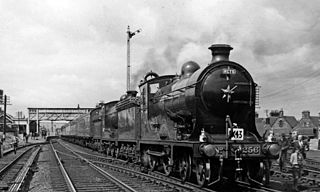
The Waverley Route was a railway line that ran south from Edinburgh, through Midlothian and the Scottish Borders, to Carlisle. The line was built by the North British Railway; the stretch from Edinburgh to Hawick opened in 1849 and the remainder to Carlisle opened in 1862. The line was nicknamed after the immensely popular Waverley Novels, written by Sir Walter Scott.
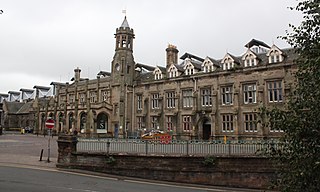
Carlisle railway station, or Carlisle Citadel, is a Grade II* listed railway station serving the city of Carlisle, Cumbria, England. It is on the West Coast Main Line, 102 miles (164 km) south east of Glasgow Central, and 299 miles (481 km) north north west of London Euston. It is the northern terminus of the Settle and Carlisle Line, a continuation of the Midland Main Line from Leeds, Sheffield and London St Pancras. It is so named because it is adjacent to Carlisle Citadel, a former medieval fortress. The station is owned by Network Rail.
The Queen of Scots was a named luxury touring train that ran exclusive tours around Scotland's scenic countryside. The train was mostly aimed at American tourists. The train ran from 1985 to 1989 as the Royal Scotsman and in 1990 as The Queen of Scots.

The Coronation Scot was a named express passenger train of the London, Midland and Scottish Railway inaugurated in 1937 for the coronation of King George VI and Queen Elizabeth which ran until the start of the war in 1939. It ran on the West Coast Main Line between London and Glasgow, stopping at Carlisle for crew change and to pick up and set down passengers to and from London only. The service was designed to compete with the rival services on the East Coast Main Line, for prestigious London to Scotland traffic. It was scheduled to complete the journey from London to Glasgow in 6 hours 30 minutes.

The Royal Scot was a British named express passenger train that ran between London Euston and Glasgow Central, the length of the West Coast Main Line (WCML), with previously a portion also going to Edinburgh.

Slateford railway station is a railway station serving Slateford in the city of Edinburgh, Scotland. It is located on the Shotts Line from Glasgow Central to Edinburgh Waverley via Shotts. The station has two platforms, connected by a stairway footbridge, and CCTV. It is managed by Abellio ScotRail.
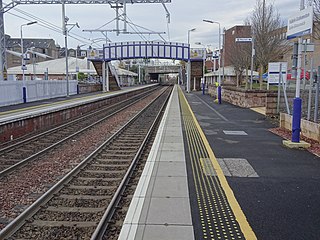
Falkirk Grahamston railway station is one of two railway stations serving the town of Falkirk in Scotland. It is located on the Edinburgh to Dunblane Line and also the Cumbernauld Line. Train services are provided by Abellio ScotRail. The "Highland Chieftain", the daily London North Eastern Railway service from London King's Cross to Inverness and vice versa also calls here.

Caledonian Sleeper is the collective name for overnight sleeper train services between London and Scotland, in the United Kingdom. It is one of only two currently operating sleeper services on the railway in the United Kingdom, the other being the Night Riviera which runs between London and Penzance.

The Race to the North was the name given by the press to occasions in two summers of the late 19th century when British passenger trains belonging to different companies would literally race each other from London to Edinburgh over the two principal rail trunk routes connecting the English capital city to Scotland – the West Coast Main Line which runs from London Euston via Crewe and Carlisle and the East Coast Main Line route from London King's Cross via York and Newcastle. The "races" were never official and publicly the companies denied that what happened was racing at all. Results were not announced officially and the outcomes have since been hotly debated. In the 20th century there were also occasions of competition for speed on the two routes.

Caledonian Railway Single No. 123 is a preserved Scottish steam locomotive. The unique 4-2-2 was built by Neilson and Company in 1886, works No. 3553, as an exhibition locomotive. In 1914 it was placed on the Caledonian Railway duplicate list, and renumbered 1123. It entered London, Midland and Scottish Railway service in 1923 and the LMS renumbered it 14010 and gave it the power classification 1P. During the 1920s it was allocated to working the directors' saloon, but it was returned to ordinary service in 1930. The locomotive was withdrawn in 1935, by which time it was the last single-wheeled express engine running in Britain, and set aside for preservation.

Baillieston railway station is located in Caledonia Road on the southern boundary of the Baillieston area of Glasgow, Scotland, with the Broomhouse area on the other side of the tracks. It is on the Whifflet Line, 8 miles (13 km) east of Glasgow Central railway station. Train services are provided by Abellio ScotRail.

Carluke railway station is a railway station on the West Coast Main Line (WCML) that serves the town of Carluke, South Lanarkshire, Scotland. The station is managed by Abellio ScotRail and is predominantly served by Argyle Line commuter trains running between Lanark and Glasgow Central. The station lies at the western edge of the town, and enjoys panoramic views of the Clyde Valley and beyond to the hills of Lanarkshire and Ayrshire.
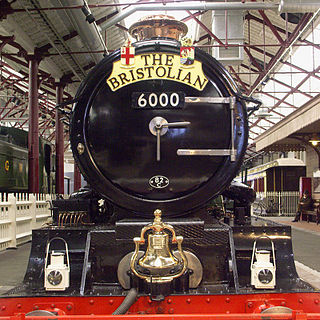
The Bristolian is a named passenger train service from London Paddington to Bristol Temple Meads. It starts at Weston-super-Mare in the London-bound direction.
The Symington, Biggar and Broughton Railway was a railway company in southern Scotland. It built a line connecting Biggar, and later Peebles, to the main line railway at Symington. It was taken over by the Caledonian Railway in 1861, and was completed in 1864.

The Thames–Clyde Express was a named express passenger train operating on the Midland Main Line, Settle-Carlisle Railway and the Glasgow South Western Line between London St Pancras and Glasgow St Enoch. Following the closure of St Enoch station in 1966, the service ran to Glasgow Central instead.

The Midland Pullman was the name given to a former express passenger train service operating on British Railways' old Midland Main Line between London St Pancras and Manchester Central via Leicester and Millers Dale. The train completed the journey in 3 hours 15 minutes.
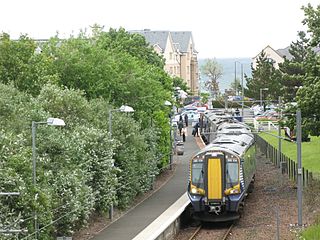
The North Berwick Branch is a short railway branch line built by the North British Railway to connect North Berwick, in East Lothian, Scotland to the East Coast Main Line. It was built as a tactical means of excluding competitors from the area, and when it opened in 1850 it was loss making. The later development of North Berwick as a resort and a golfing centre transformed the branch line.

The Mid-Day Scot was a British express passenger train launched in 1927 running from Edinburgh Princes Street and Glasgow Central, joining to form a train to London Euston.

The Shotts Line is a suburban railway line linking Glasgow Central and Edinburgh Waverley via Shotts in Scotland. It is one of the five rail links between the two cities.


















